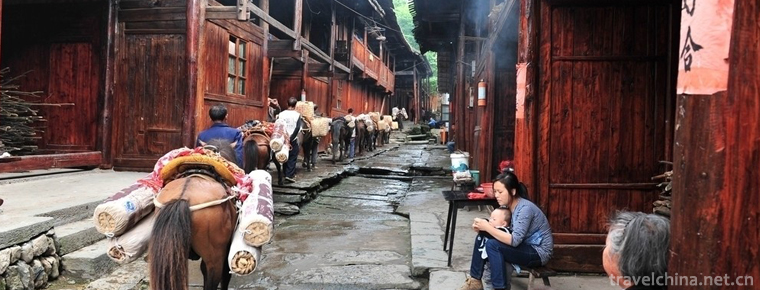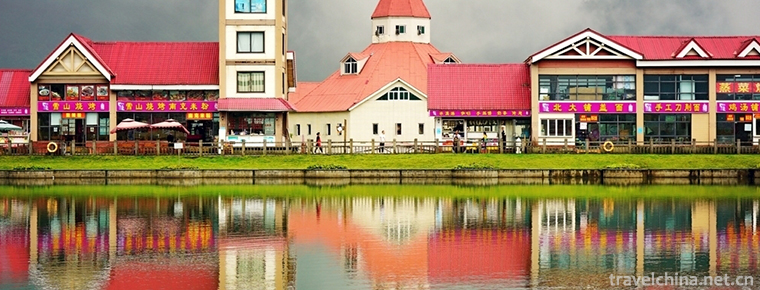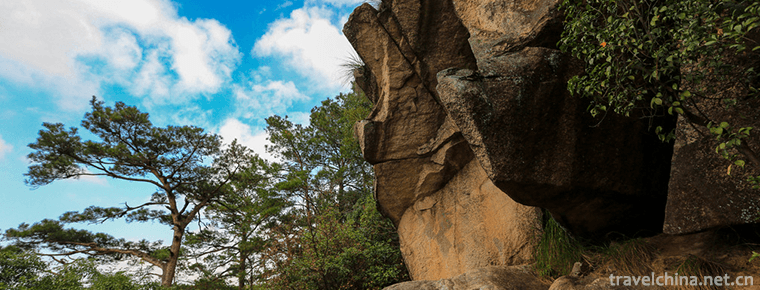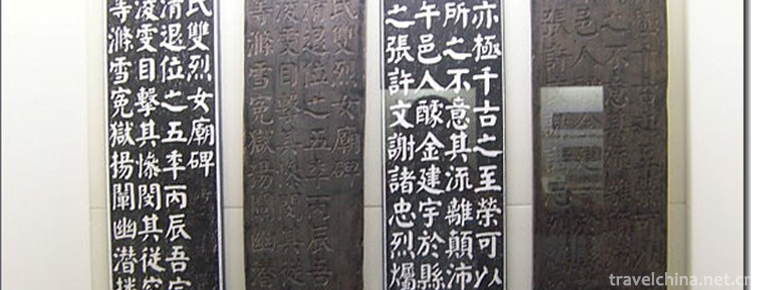Mudan River Side Wall
Mudan River Side Wall
The Mudanjiang Side Wall was built in the Tang Dynasty, presumably at the junction of Mudanjiang City in Heilongjiang Province and the northeast of Hailin County. The Eastern and western ends follow the east-west direction of the mountain body, and the middle part crosses the valley. It strikes southeast and northwest. Its basic position is between 130 degrees in East diameter and 45 degrees in North latitude.
The Mudanjiang side wall, consisting of three discontinuous sections, is distributed in the mountainous areas of Aimin District and Ningan City of Mudanjiang City. From north to south, the wall length of Mudanjiang section is 38.629 km, the wall length of East section is 22.394 km, and the wall length of Jingbohu section is 4.996 km. The whole wall length of the three sections is from southeast to northwest, with a total length of 66.019 km. The existence and discovery of the Mudanjiang border wall provide rare physical evidence for the study of archaeological work of ethnic minorities in the northeastern frontier of Tang Dynasty in China.
On May 25, 2006, the Mudan River Side Wall was announced by the State Council of the People's Republic of China as the Sixth Batch of national key cultural relics protection units.
Historical evolution
During the period from the founding of Zhenguo to the official seal of Tang Dynasty (698-713), Gao Wang Dazorong built the side wall of Jingbo Lake section.
Wuwang Dawuyi built the side walls of Mudanjiang section and the east section of the Yangtze River during the period of "striking black water in the north" (726-732).
In the thirteenth year of the Republic of China (1924), Ning'an County Chronicle Volume 3, Historical Sites and Ancient City Title recorded: "Deng this ancient city (city wall Laizi Mountain City) to look at the southern bank of the lake (actually the eastern bank), with a side wall, about 5 feet high, directly to Yanji, not knowing the number of miles, Gai Liaojin has the most important border fortress, such as the existing Taizhou fortress in the north of Taoer River in Jiangsu Province."
In the spring of 1964, Heilongjiang Museum staff first investigated the side wall of Jingbo Lake section.
In July 1979, Mudanjiang Cultural Relics Management Station first discovered the side wall of Mudanjiang section.
In the summer of 1982, the Heilongjiang Provincial Cultural Relics and Archaeology Team reviewed the side walls of Jingbo Lake Section.
In April 1984, Mudanjiang Mudanjiang Mudanjiang Cultural Relics Management Station completed a full investigation of the side walls of the Mudanjiang section.
In 1992, Mudanjiang Cultural Relics Management Station and Ningan Cultural Relics Management Institute first discovered the side wall of the eastern section of the Yangtze River.
In 2007, Mudanjiang City established the Leading Group of Great Wall Resources Survey, which has offices located at Mudanjiang Cultural Relics Management Station.
From 2008 to 2010, Mudanjiang Mudanjiang Cultural Relics Management Station completed a field survey of multi-section sidewalls in Mudanjiang.
protective measures
In 1981, the city wall Laizi Mountain City was declared as a cultural relic protection unit in Heilongjiang Province.
In 2005, Chongyihe Mountain City was declared as a cultural relic protection unit in Heilongjiang Province.
On May 25, 2006, "Mudan River Side Wall" was announced by the State Council of the People's Republic of China as the Sixth Batch of national key cultural relics protection units.
Historical culture
From 691 to 692, the Tang army stationed in Yingzhou defeated the Heishui Mao tribal alliance under the leadership of Li Duozuo, and forced the forces of Heishui Mao to return to the original place of Sanjiang Plain. However, in the subsequent Yingzhou Rebellion, the Tang Dynasty who guarded the area was transferred back to suppress Yingzhou, which made the Tang Army extremely empty. The Heishui Mohe tribal alliance expanded southward again. By the time of the establishment of the seismogenic state in Dazhuorong, the Heishui Mohe tribal alliance might have been the northern boundary of the seismogenic state and the Heishui Mou tribal alliance, even if it had not expanded to the middle and lower reaches of Mudanjiang River. Buffer zone between force ranges. In order to solve the pressure and threat brought by the southern expansion of Heishui Mohe tribal alliance, Dazorong preferred to build defensive fortifications along its northern border, and the side wall of Jingbo Lake section should be built at this time. It is precisely because of the military defense line on the northern frontier that the earthquake-stricken country survived the crisis in the early stage. Da Zou Rong could devote himself to developing national strength. In a few years, he made himself "more than 100,000 households and tens of thousands of soldiers won".
Tourism information
address
The boundary between Mudanjiang City and the northeast of Hailin County in Heilongjiang Province.
Admission ticket
Free Admission.
traffic
Drive through 301 National Highway and Heda Highway to Mudan River Side Wall.


-
Tea horse ancient road
Tea-horse ancient road refers to the folk international trade.
Views: 216 Time 2018-10-17 -
Serdang snow mountain Xiling snow mountain
Xiling Snow Mountain, located in Dayi County, Chengdu City, Sichuan Province, is only 95 kilometers away from Chengdu, with a total area of 483 square kilometers. It is a world natural heritage.
Views: 139 Time 2018-10-30 -
Tiantangzhai Tourist Scenic Area
Tiantangzhai (National AAAAA Tourist Scenic Spot, National Nature Reserve, National Forest Park and National Geological Park) is the second peak of the Dabie Mountains.
Views: 184 Time 2018-12-08 -
Yeliguan Scenic Area
Yeliguan Scenic Area is located in Lintan County, with Yeliguan of Lintan County as the center. It is divided into four scenic areas: Lianhuashan, Xixia, Dongxia and Yehai Lake..
Views: 155 Time 2018-12-26 -
Drum Mountain
Gushan is located in the east of Jin'an District, Fuzhou City, Fujian Province, and on the North Bank of Minjiang River. It is about 8 kilometers away from the downtown area. It is one of the most fam.
Views: 100 Time 2019-01-12 -
Traditional drama
Chinese drama mainly includes opera and drama, and opera is the traditional Chinese drama. After a long period of development and evolution, Baihua Garden of Chinese opera has gradually .
Views: 147 Time 2019-04-21 -
Rubbing and Printing Skills of Hengshui Inscriptions
Hengshui Law Tie Engraving and Printing Technology, the traditional handicraft of Taocheng District, Hengshui City, Hebei Province, is one of the national intangible cultural heritage..
Views: 192 Time 2019-05-03 -
Hengshui painting
Hengshui Inner Painting, a traditional folk art in Hengshui, Hebei Province, is one of the national intangible cultural heritage..
Views: 208 Time 2019-05-03 -
Deng Xiaoping
Deng Xiaoping (August 22, 1904 -1997 February 19th), formerly known as Deng Xiansheng, the scientific name of Deng Xixian, Guang'an, Sichuan. Go to Europe early Work study program After his return, he.
Views: 330 Time 2019-09-07 -
Fobao scenic spot
Fobao scenic spot, located 128 kilometers southeast of Sichuan Province, is located in the southern edge of Sichuan Basin. It is a primeval forest area at the tail of the North vein of Dalou mountain. It covers an area of 380 square kilometers. It has the characteristics of mountain, water, stone and forest. It is a subtropical humid climate with superior natural conditions and well preserved vegetation..
Views: 171 Time 2020-10-16 -
Plant resources in Neijiang
Neijiang City is a subtropical evergreen broad-leaved forest belt with mild climate and abundant rainfall, which is suitable for the growth of a variety of trees. There are more than 60 subjects, 110 genera and 190 species. Neijiang is mainly composed of timber forest.
Views: 304 Time 2020-12-16 -
Guangan economy
In 2019, the GDP of Guang'an City will reach 125.04 billion yuan, an increase of 7.5% over the previous year (the same below). Among them, the added value of the primary industry was 20.43 billion yuan, an increase of 2.8%; the added value of the secon.
Views: 355 Time 2020-12-19









